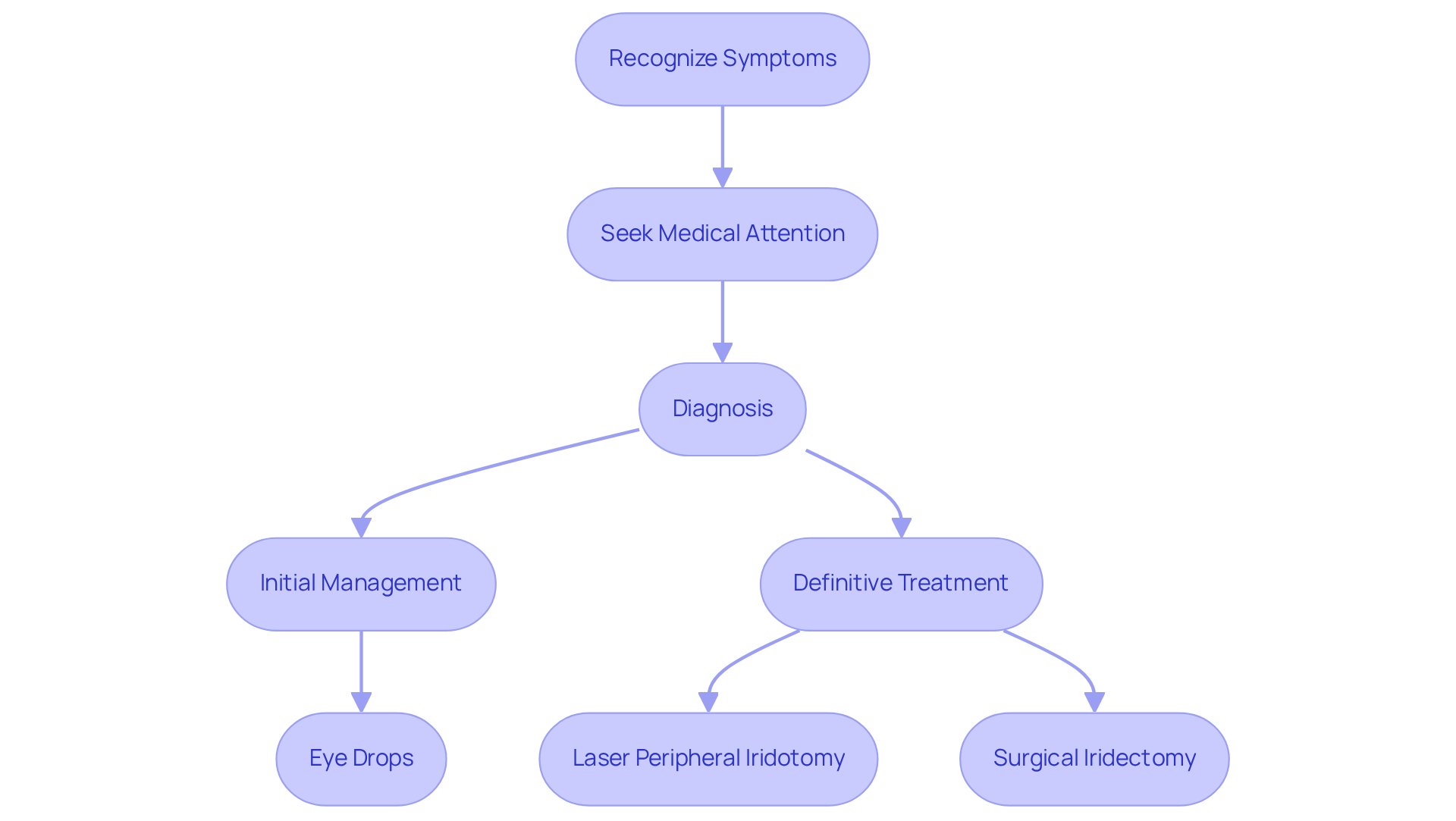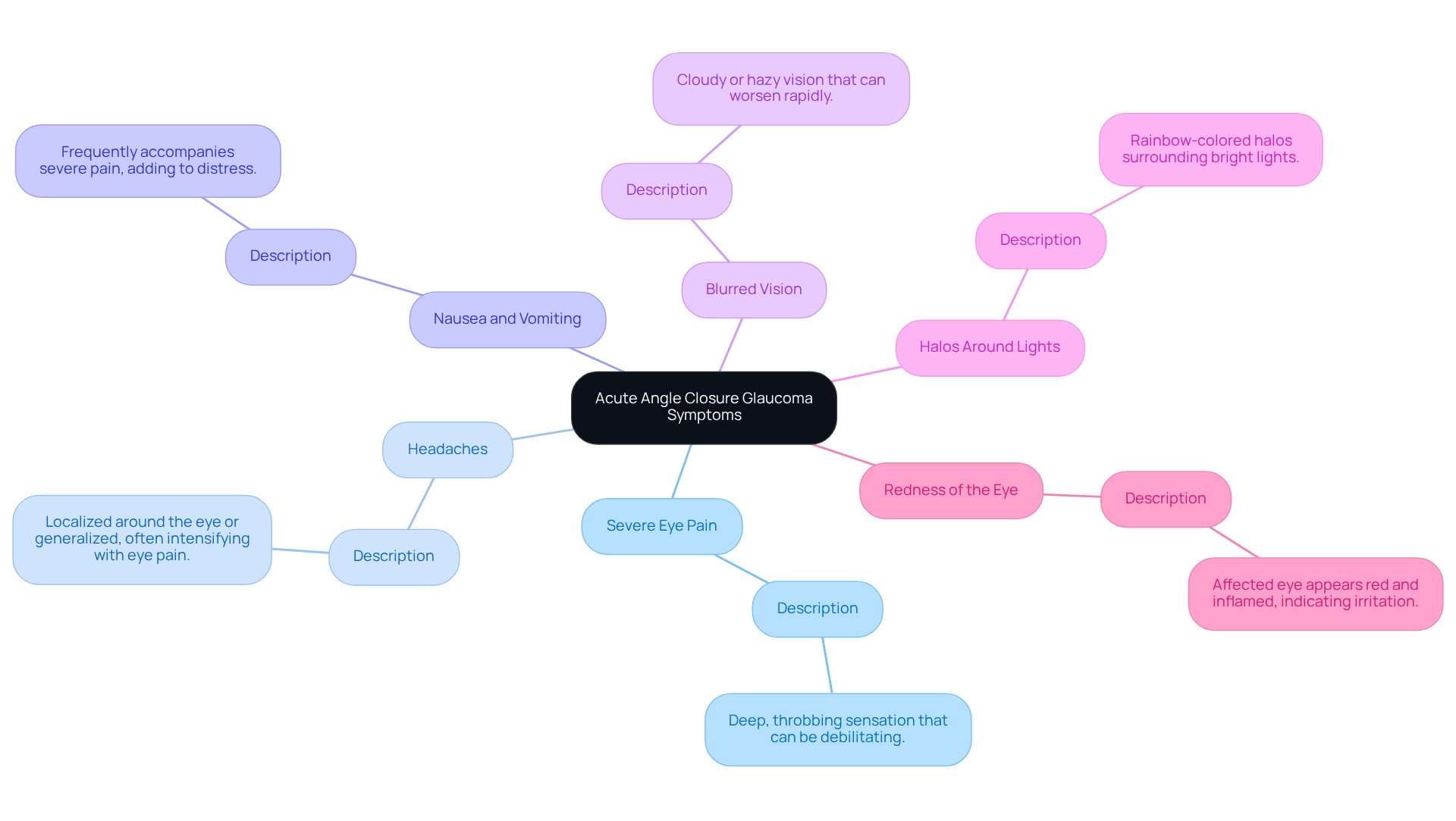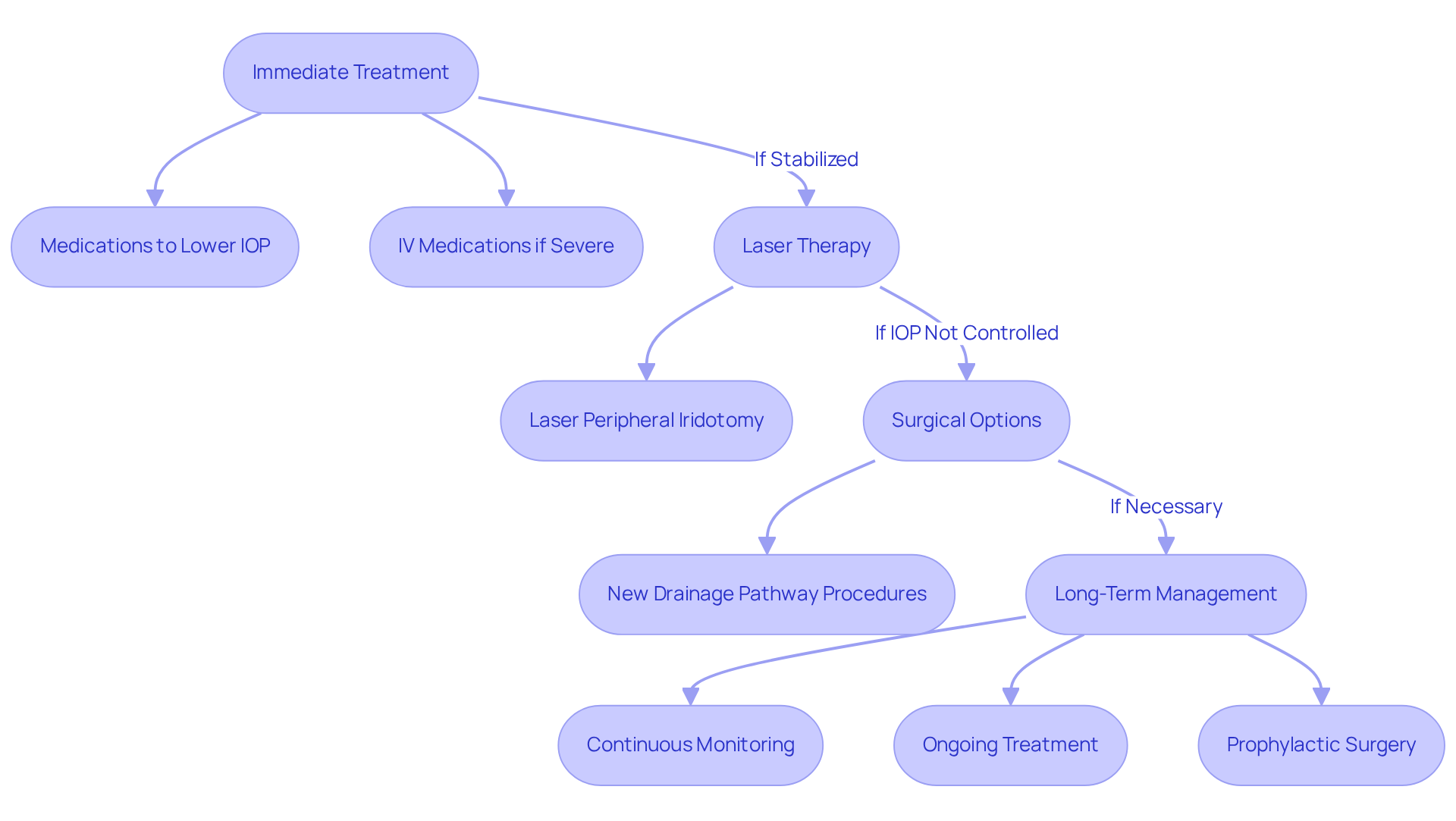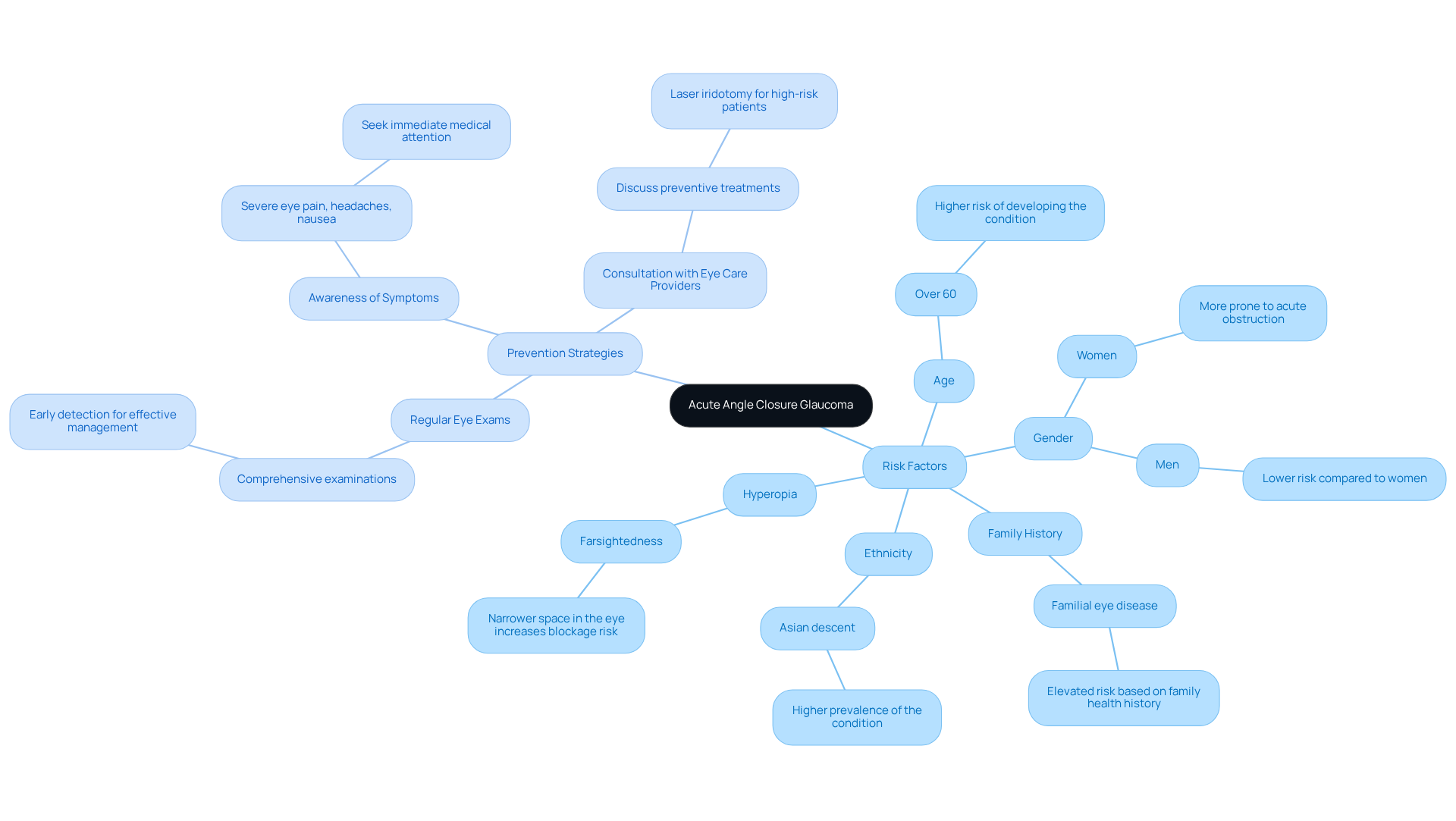Posted by: Northwest Eye in General on July 16, 2025
Overview
Acute angle closure glaucoma (AACG) is a serious ocular emergency that can understandably cause concern. It is characterized by a rapid increase in intraocular pressure due to a blockage in the eye’s drainage system. This condition can lead to severe symptoms and potential vision loss if not treated promptly, and we understand how alarming that can be.
Immediate medical intervention is crucial. We want you to know that there are effective treatment options available, including:
- Medications
- Laser therapy
- Surgical procedures
These approaches can help manage the condition and prevent long-term complications, providing you with the reassurance you need.
It’s common to feel overwhelmed in such situations, but remember that you are not alone. We are here to help you through this process, ensuring that you receive the care you need. Please don’t hesitate to seek help, as timely action can make a significant difference in your outcome.
Introduction
Acute angle closure glaucoma (AACG) is a serious eye condition that requires immediate attention. It often presents with distressing symptoms, such as severe eye pain and nausea, which can be alarming. We understand how overwhelming this can feel. It’s crucial to grasp the complexities of this ocular emergency, as timely intervention can significantly impact your vision.
With the increasing prevalence of AACG among certain groups, including older adults and specific ethnic communities, recognizing the signs becomes vital. How can you effectively identify these symptoms and navigate the treatment process? This article explores the signs, risks, and management strategies for AACG, equipping you with the essential knowledge to protect your eye health.
We are here to help you through this process.
Define Acute Angle Closure Glaucoma
Acute angle closure glaucoma (AACG) is a serious ocular emergency that can be alarming, characterized by a rapid increase in intraocular pressure (IOP) due to a blockage in the eye’s drainage region. This blockage often occurs when the iris is pushed forward, narrowing or completely closing the space between the iris and cornea. If not addressed promptly, acute angle closure glaucoma can lead to significant vision loss or even blindness. We understand that symptoms such as severe eye pain, headaches, nausea, and vomiting can be distressing, making essential to prevent irreversible damage to the optic nerve.
The incidence of AACG tends to increase with age, particularly affecting individuals between 55 and 65 years old. It is more prevalent among women and certain ethnic groups, including those of Southeast Asian and Chinese descent. Research indicates that untreated acute angle closure glaucoma can lead to temporary vision loss or blindness, with an untreated eye having a 40% to 80% chance of developing acute angle closure glaucoma within 5 to 10 years. This statistic can be concerning, but knowing the risks can empower you to seek timely care.
Understanding the anatomical predispositions that contribute to acute angle closure glaucoma is crucial. Individuals with hypermetropia face an increased risk due to the structural anatomy of their anterior chamber, which can create a shallower space between the iris and cornea. This condition can escalate to acute angle closure glaucoma, which is characterized by a significant increase in IOP despite treatment efforts. It’s common to feel anxious about these risks, but being informed is the first step toward protection.
Real-world examples underscore the importance of prompt diagnosis and treatment. Initial emergency management for acute angle closure glaucoma typically involves administering eye drops to lower IOP temporarily, followed by definitive treatments such as laser peripheral iridotomy (LPI) or surgical iridectomy when necessary. These interventions are vital for preventing future angle-closure attacks and preserving your vision. We are here to help you through this process and ensure you receive the best care possible.
In summary, acute angle closure glaucoma is a serious condition that requires prompt attention. Early detection and timely treatment are paramount to achieving favorable outcomes and preventing long-term vision impairment. Remember, you are not alone in this; we are here to support you every step of the way.

Identify Symptoms of Acute Angle Closure Glaucoma
Symptoms of acute angle closure glaucoma can appear suddenly, and we recognize how distressing this situation can be. These symptoms may include:
- Severe eye pain: This is often described as a deep, throbbing sensation that can be debilitating. Many patients report severe eye pain during episodes of acute angle closure glaucoma, underscoring the urgency of recognizing this symptom.
- Headaches: These may be localized around the eye or more generalized, often intensifying alongside the eye pain.
- Nausea and vomiting: These frequently accompany the severe pain, adding to the distress you may feel.
- Blurred vision: You might experience cloudy or hazy vision, which can worsen rapidly.
- Halos around lights: It’s common for individuals to notice rainbow-colored halos surrounding bright lights, a distinctive symptom of this condition.
- Redness of the eye: The affected eye may appear red and inflamed, indicating irritation and increased pressure.
Recognizing these symptoms promptly is crucial, as they signal a medical emergency that necessitates immediate attention. As the Cleveland Clinic indicates, ‘If you experience an episode of acute angle closure glaucoma, treat it as a medical emergency.’ Early recognition and treatment can prevent irreversible damage to vision, making it essential for you to seek help if you experience these alarming symptoms. Furthermore, managing acute angle closure glaucoma often requires a collaborative approach involving an ophthalmologist and other healthcare professionals. Routine eye examinations are essential for early identification of the condition, highlighting the importance of proactive eye care. We are here to help you through this process.

Explore Treatment Options for Acute Angle Closure Glaucoma
Efficient therapy for acute obstruction requires both urgent and sustained approaches to control intraocular pressure and avert vision impairment. We understand that facing such a situation can be overwhelming, and we are here to guide you through it.
- Immediate Treatment: Initial management typically involves medications aimed at lowering intraocular pressure (IOP). Commonly used agents include oral carbonic anhydrase inhibitors, topical beta-blockers, and prostaglandin analogs. In more severe cases, intravenous medications may be administered to achieve rapid pressure reduction. It’s common to feel anxious during this phase, but rest assured that these treatments are effective in stabilizing your condition.
- Laser Therapy: Following the stabilization of IOP, laser peripheral iridotomy is often performed. This procedure involves creating a small opening in the peripheral iris, facilitating better fluid drainage and alleviating pressure within the eye. Research shows that laser peripheral iridotomy has a high success rate in preventing additional instances of acute narrow-angle eye pressure. Many patients have shared how relieved they felt after this procedure.
- Surgical Options: If laser treatment does not adequately control IOP, surgical interventions may be necessary. These procedures aim to establish a new drainage pathway for the aqueous humor, thereby enhancing fluid outflow and reducing pressure. We know that the thought of surgery can be daunting, but our team will be with you every step of the way.
- Long-Term Management: Continuous monitoring and follow-up appointments are crucial for managing IOP and preventing recurrence. Patients may require ongoing treatment, including medications and regular eye exams, to ensure optimal eye health. It is also important to note that the contralateral eye is susceptible to acute angle closure glaucoma, and prophylactic surgery, such as laser peripheral iridotomy, is recommended. We are committed to supporting your long-term health and well-being.
Eye care professionals emphasize that swift intervention is essential to preserve visual function. As one specialist pointed out, ‘The outlook of acute angle closure glaucoma is greatly affected by early identification and swift intervention.’ With and a collaborative approach to care—including the potential of artificial intelligence to enhance eye condition detection and management—patients can achieve favorable outcomes and maintain their vision. Remember, we are here to help you through this process.

Understand Risk Factors and Prevention Strategies
Acute angle closure glaucoma is influenced by several key risk factors that we should be aware of:
- Age: If you are over 60, it’s important to know that you are at a significantly higher risk of developing this condition.
- Gender: Women tend to be more prone to acute obstruction of the eye than men, which is worth noting.
- Family History: A familial history of eye disease can elevate your risk, so it’s essential to consider your family’s health history.
- Ethnicity: Certain ethnic groups, particularly those of Asian descent, exhibit a higher prevalence of this condition, which may affect you or your loved ones.
- Hyperopia (Farsightedness): This refractive error can lead to a narrower space in the eye, raising the probability of blockage, so understanding your vision health is vital.
To help mitigate the risk of acute angle closure glaucoma, we encourage you to adopt the following preventive strategies:
- Regular Eye Exams: We recommend scheduling comprehensive eye examinations, especially if you possess any of the aforementioned risk factors. Early detection is crucial for effective management. Routine examinations can help detect risks and enable early intervention, as emphasized in case studies on the prevention of angle-closure eye conditions.
- Awareness of Symptoms: It’s important to familiarize yourself with the signs of acute angle closure glaucoma, which include severe eye pain, headaches, and nausea. If you experience these symptoms, please seek immediate medical attention, as timely intervention is essential to preserve your vision and avoid complications like blurred vision and sensitivity to light.
- Consultation with Eye Care Providers: We encourage you to discuss with your eye care provider the potential need for preventive treatments, particularly if you are identified as being at high risk. This may include procedures like laser iridotomy, which can help prevent future episodes and is a common recommendation for those at risk.
Real-world examples of prevention strategies highlight the importance of regular screenings and proactive management of health conditions, such as diabetes, which can exacerbate risks associated with angle closure glaucoma. By maintaining a vigilant approach to your eye health, you can significantly reduce your chances of developing this serious condition. Remember, we are here to help you through this process.

Conclusion
Acute angle closure glaucoma is a critical condition that requires our immediate attention and understanding. We understand that recognizing the symptoms and the associated risks can be overwhelming, but it’s crucial to explore effective treatment options to prevent irreversible vision loss. Awareness and timely intervention are essential; neglecting this ocular emergency can lead to severe consequences.
Key insights to consider include the alarming symptoms such as:
- Severe eye pain
- Headaches
- Nausea that signal the need for urgent medical help.
It’s common to feel anxious when faced with such symptoms. Additionally, various risk factors, including:
- Age
- Gender
- Ethnicity
can predispose individuals to this condition. We emphasize the importance of early detection through regular eye exams and proactive management strategies, such as laser treatments, to mitigate risks effectively.
Ultimately, safeguarding your eye health is a shared responsibility that requires vigilance and proactive measures. By understanding acute angle closure glaucoma and its implications, you can take informed steps toward prevention and timely treatment. Encouraging regular check-ups and fostering awareness about the symptoms can significantly enhance your chances of preserving vision and maintaining overall eye health. Remember, taking action today can make a difference for a healthier tomorrow.
Frequently Asked Questions
What is acute angle closure glaucoma (AACG)?
Acute angle closure glaucoma (AACG) is a serious ocular emergency characterized by a rapid increase in intraocular pressure (IOP) due to a blockage in the eye’s drainage region, often caused by the iris being pushed forward and narrowing or closing the space between the iris and cornea.
What are the symptoms of acute angle closure glaucoma?
Symptoms of acute angle closure glaucoma include severe eye pain, headaches, nausea, and vomiting. These symptoms can be distressing and require immediate medical intervention to prevent irreversible damage to the optic nerve.
Who is most at risk for developing acute angle closure glaucoma?
The incidence of AACG increases with age, particularly affecting individuals between 55 and 65 years old. It is more prevalent among women and certain ethnic groups, including those of Southeast Asian and Chinese descent.
What are the risks of untreated acute angle closure glaucoma?
Untreated acute angle closure glaucoma can lead to temporary vision loss or blindness. An untreated eye has a 40% to 80% chance of developing acute angle closure glaucoma within 5 to 10 years.
How does hypermetropia relate to acute angle closure glaucoma?
Individuals with hypermetropia face an increased risk of acute angle closure glaucoma due to the structural anatomy of their anterior chamber, which can create a shallower space between the iris and cornea.
What is the initial management for acute angle closure glaucoma?
Initial emergency management typically involves administering eye drops to temporarily lower IOP, followed by definitive treatments such as laser peripheral iridotomy (LPI) or surgical iridectomy when necessary.
Why is early detection and treatment important for acute angle closure glaucoma?
Early detection and timely treatment are crucial for achieving favorable outcomes and preventing long-term vision impairment in individuals with acute angle closure glaucoma.






